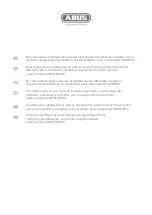
26
1600751-4D
4.3.11 Träbert, 2
–
5 Current
The 2-
5 or ‘Ultra
-
Reiz’ current was introduced by Träbert.
1
It is often used to treat headaches
and neck pain. The 2-5 current is a faradic rectangular pulsed current with a phase duration of
2ms and a phase interval of 5ms. These settings are the default settings for the faradic
rectangular current waveform and result in a pulse frequency of approximately 143 Hz. Träbert
offered no explanation for the choice of these parameters. Nevertheless, many workers have
adopted the therapy and it is still applied with success. A remarkable effect is the freedom from
pain which can appear from just the first treatment and which can last for several hours. See fig
12.9 for a graphical representation.
1 Träbert, H.
Ultra-Reizstrom, ein neues therapeutisches Phänomen,
Elektromedizin 2, 1957 (7).
CAUTION:
•
Faradic currents are monophasic currents that produce electrolysis by-products. These
by-products can result in burns beneath the electrodes. Always use properly moistened
sponge / electrode combinations to absorb these by-products during treatment. See
paragraph 10.1.5 for details.
Parameters:
Phase Duration
, expressed in ms or s,
is the elapsed time from the beginning to the
termination of the pulse phase. The default setting is 2ms. See fig 12.9 for details.
Phase Interval
, expressed in ms or s, is the elapsed time between succeeding pulse phases.
The default setting is 5ms. See fig 12.9 for details.
4.4 The Strength-Duration Curve (SD Curve)
To achieve a better understanding of the excitability of nerves and muscles, we must consider
the strength (amplitude) an de duration (ON time) of the applied current, since a relation exist
between the strength and the duration necessary to elicit a threshold response from nerve and
muscle. By varying the strength and duration of the electrical stimulus, it is possible to plot a
curve called the strength-duration (SD) curve that gives a graphic illustration of the excitability of
nerve and muscle. The strength-duration curves for nerve muscle are very characteristic and
are readily reproducible.
Although the shape of the SD curve is similar for both nerve and muscle, the position of the
curve on the graph will vary according to the innervation status of the muscle (innervated,
partially denervated, or completely denervated).
Two important numerical values that can be determined from the SD curve are the rheobase
and the Chronaxie.
The rheobase (threshold) is the minimal strength of an electrical stimulus of infinite duration that
is capable of exciting a tissue (nerve or muscle).
Chronaxie is the duration of an electrical stimulus of twice the rheobase value that will cause a
minimal response (ie, muscle twitch).
The Chronaxie of an intact nerve (healthy, innervated muscle) is much lower (approximately
0.03 ms) that that of a denervated muscle (approximately 10 ms). These values illustrate the
fact that healthy, innervated muscle is much more excitable than is unhealthy, denervated
muscle. Therefore, healthy, innervated muscle will respond best to a stimulus of sufficient
amplitude and of short duration, whereas an impulse of long duration and of greater amplitude is
required to effectively stimulate denervated muscle. Therefore, the SD curve illustrates the
relationship between the time (duration) that an electrical stimulus required to produce a
threshold response (muscle twitch)
Summary of Contents for 1600905
Page 1: ...6 series User Manual ...
Page 3: ...6 series User Manual ...
Page 4: ......
Page 5: ...3 1600751 4D ...
Page 90: ...88 1600751 4D ...
Page 92: ...90 1600751 4D 13 6 3 LP 13 6 4 CP 13 6 5 CPid ...
Page 95: ...93 1600751 4D 13 7 7 IG150 Monophasic Envelope 13 7 8 IG150 Biphasic Envelope ...
















































